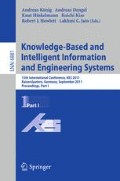Abstract
The theory of nonlinear dynamical systems has opened doors to discovering potential patterns hidden in complex time-series data. An attrative approach to nonlinear time-series analysis is the measure of predictability which characterizes the data in terms of entropy. A new entropy measure is presented in this paper as a new nonlinear dynamical method, which is based on the theory of possibility and the kriging computation. The proposed model has the potential for studying complex biosignals.
Access this chapter
Tax calculation will be finalised at checkout
Purchases are for personal use only
Preview
Unable to display preview. Download preview PDF.
References
Kaplan, D., Glass, L.: Understanding Nonlinear Dynamics. Springer, New York (1995)
Voss, A., et al.: Methods derived from nonlinear dynamics for analysing heart rate variability. Phil. Trans. R. Soc. A 367, 277–296 (2009)
Pincus, S.M.: Approximate entropy as a measure of system complexity. Proc. Natl. Acad. Sci. USA 88, 2297–2301 (1991)
Pincus, S.M., Goldberger, A.L.: Physiological time-series analysis: what does regularity quantify? Am. J. Physiol. 4, H1643–H1656 (1994)
Pincus, S.M.: Approximate entropy (ApEn) as a complexity measure. Chaos 5, 110–117 (1995)
Grassberger, P., Procaccia, I.: Estimation of the Kolmogorov entropy from a chaotic signal. Phys. Rev. A 28, 2591–2593 (1983)
Eckmann, J.P., Ruelle, D.: Ergodic theory of chaos and strange attractors. Rev. Modern. Phys. 57, 617–654 (1985)
Kannathal, N., et al.: Entropies for detection of epilepsy in EEG. Comput. Meth. Programs Biomed. 80, 187–194 (2005)
Srinivasan, V., Eswaran, C., Sriraam, N.: Approximate entropy-based epileptic EEG detection using artificial neural networks. IEEE Trans Information Technology in Biomedicine 11, 288–295 (2007)
Richman, J.S., Moorman, J.R.: Physiological time-series analysis using approximate entropy and sample entropy. Amer. J. Physiol. Heart Circ. Physiol. 278, H2039–H2049 (2000)
Costa, M., Goldberger, A.L., Peng, C.K.: Multiscale entropy analysis of complex physiologic time series. Phys. Rev. Lett 89, 068102-1–068102-4 (2002)
Chen, W., Zhuang, J., Yu, W., Wang, Z.: Measuring complexity using FuzzyEn, ApEn, and SampEn. Medical Engineering & Physics 31, 61–68 (2009)
Lewis, M.J., Short, A.L.: Sample entropy of electrocardiographic RR and QT time-series data during rest and exercise. Physiological Measurement 28, 731–744 (2007)
Lee, M.-Y., Yang, C.-S.: Entropy-based feature extraction and decision tree induction for breast cancer diagnosis with standardized thermograph images. Comput. Meth. Programs Biomed. 100, 269–282 (2010)
Pham, T.D.: GeoEntropy: a measure of complexity and similarity. Pattern Recognition 43, 887–896 (2010)
Zadeh, L.A.: Fuzzy sets as a basis for a theory of possibility. Fuzzy Sets Syst. 100, 9–34 (1999)
Isaaks, E.H., Srivastava, R.M.: An Introduction to Applied Geostatistics. Oxford University Press, New York (1989)
Journel, A.G., Rao, S.E.: Deriving conditional distribution from ordinary kriging, Stanford Center for Reservoir Forcasting. Stanford University Report (29), 25 (1996)
Brennan, M.-L., Penn, M.S., Van Lente, F., Nambi, V., Shishehbor, M.H., Aviles, R.J., Goormastic, M., Pepoy, M.L., McErlean, E.S., Topol, E.J., Nissen, S.E., Hazen, S.L.: Prognostic value of myeloperoxidase in patients with chest pain. New Eng. J. Med. 13, 1595–1604 (2003)
Pham, T.D., Wang, H., Zhou, X., Beck, D., Brandl, M., Hoehn, G., Azok, J., Brennan, M.L., Hazen, S.L., Li, K., Wong, S.T.C.: Computational prediction models for early detection of risk of cardiovascular events using mass spectrometry data. IEEE Trans Information Technology in Biomedicine 12, 636–643 (2008)
Author information
Authors and Affiliations
Editor information
Editors and Affiliations
Rights and permissions
Copyright information
© 2011 Springer-Verlag Berlin Heidelberg
About this paper
Cite this paper
Pham, T.D. (2011). Possibilistic Entropy: A New Method for Nonlinear Dynamical Analysis of Biosignals. In: König, A., Dengel, A., Hinkelmann, K., Kise, K., Howlett, R.J., Jain, L.C. (eds) Knowledge-Based and Intelligent Information and Engineering Systems. KES 2011. Lecture Notes in Computer Science(), vol 6881. Springer, Berlin, Heidelberg. https://doi.org/10.1007/978-3-642-23851-2_48
Download citation
DOI: https://doi.org/10.1007/978-3-642-23851-2_48
Publisher Name: Springer, Berlin, Heidelberg
Print ISBN: 978-3-642-23850-5
Online ISBN: 978-3-642-23851-2
eBook Packages: Computer ScienceComputer Science (R0)

